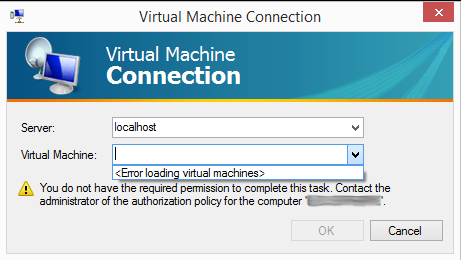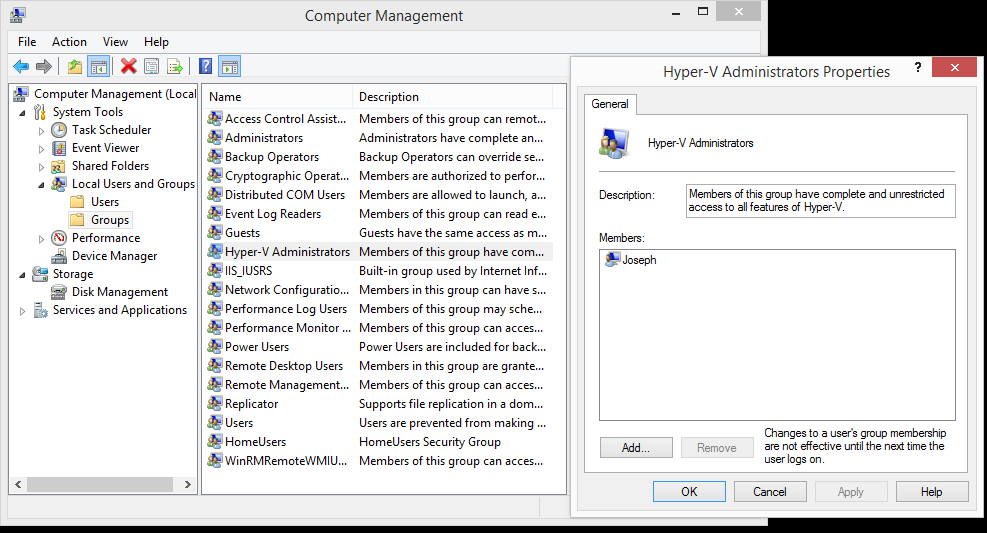So maybe you’ve been bold like I have and installed Windows 8.1. And maybe you want to use the new Hyper-V portion of 8.1 and setup a VM or two to play with. In the process, you discover this great feature called Hyper-V Virtual Machine Connection, which is essentially like a RDP connection for Hyper-V virtual machines. In other words, using this connection, you can now treat a VM like a full screen RDP session!
This feature was new to me and I was super excited to see it. However, when I launched it, I got the following message.
[callout] You do not have the required permission to complete this task. Contact the administrator of the authorization policy for the computer ‘MYCOMPUTERNAME’.[/callout]
If you try and select the Virtual Machine dropdown box, it says “<Error loading virtual machines>”.
It seems a bit odd to me that I can’t access VM’s located on my local machine, especially when I’m a local administrator. After looking around a bit, I found that there is a local Hyper-V Administrators group that by default is empty. Add yourself to the group by doing the following:
- Access the Computer Management interface. In Windows 7 and Windows 8, this can be found by simply searching for Computer Management.
- Expand the Local Users and Groups section and click on Groups
- Double click on the Hyper-V Administrators group
- In the Dialogue box, click Add… and then enter your user name in the box and hit OK. Hit OK again and close out of Computer Management
- One more caveat. In my experience, I needed to log out and log back into Windows for the changes to work.
After completing these steps, I was able to use the Hyper-V Virtual Machine Connection tool to connect to my local Hyper-V VMs with no problems whatsoever. Hope that helps, and as always, comment to let me know your thoughts. Thanks!



Thanks for this tip. I found out that running the VMConnection app elevated worked, but I didn’t want to have to do that every time.
Thanks for the info!! I had same problem.
Awesome. Glad to know it helped you guys!
Nop, still does not work for me. Had to run it in elevated mode to make it work. Windows Server 2012 here.
Joseph,
I know this is an old article but I wanted to thank you regardless. This worked great for me.
Thanks man! I’m happy it’s still relevant and helpful for people like you.
Still relevant. Im using this environment as a lab so this is crucial. Thanks
Direct and to the point. I found a few incredibly complex recommended ways to fix it, and it was actually quite simple – as you demonstrated. Also using Hyper-V, in Windows 8.1 as a CentOS lab, and this fix worked great. Thanks!
Thanks mate – worked a charm!
Thanks a lot.
Wow. I can’t believe how much searching it took me to find this. Most solutions I could find were for domains using InitialStore.xml. I can’t believe there isn’t a more straightforward message on the interface other than “Verify that your user account has permission to access virtual machines.”
I can not express my gratitude. I hated having to elevate to connect to my VMs.
Happy Holidays!
For those of you running this on a domain controller, you probably noticed there is no Local Users and Groups. I found that going through the command prompt did work, using this command:
net localgroup “Hyper-V Administrators” /add “\”
It should go without saying, but don’t forget to replace yourdomain.com and your username with the appropriate info.
I’m using WinXP as a VM within Windows 10 and encountered this issue. Easily solved using your directions. Thanks for enlightening us!
The hours I spent chasing around with InitialStore.xml resolutions… Thank you sooo much. Still relevant!
Thanks
Excellent! Glad it’s still helping someone. 🙂
Was trying to test Server 2009 as a VM on my Windows 10 host, this fixed the issue perfectly (I also needed to log out).
Thanks for the simple, quick fix.
Fixed my issue for executing Copy-VMFile on Powershell. Thank you!
In a windows 2022 domain on a windows 2019 server you have to put in the domain admin group in stead of the domain user you use to login to te 2019 server.